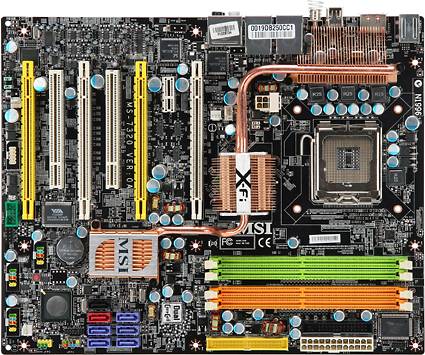Nvidia 680i Motherboard Comparison Part 2
MSI P6N Diamond: Baked Alaska
Announced in November for release the middle of December...make that the end of January...uh, perhaps mid March, MSI is looking forward to a revolution in its top 680i entry.
Feature Overview
MSI is behind a startling concept in performance motherboards: Ultimate features combined with ultimate value. The company starts off with a Creative X-Fi Xtreme Audio sound processor which, unlike the $60 card, supports front panel audio connection typically found on motherboards. This bit of brilliance could be the reason for so many delays, as bus timing issues in Creative's higher-end audio processors have traditionally required extra tweaking prior to release. Add full-version X-Fi Vista driver delays to MSI's list of worries, and the company might just have its product ready in a few weeks.
The first thing that stands out about MSI's design is the use of four PCI-Express x16 graphics card slots. Electronic switching automatically selects 16/x16/x8 modes or x16/x8/x8/x8 modes depending on which slots are filled, and the board functions well with four graphics cards. Nvidia's drivers unfortunately didn't allow combining an 8800GTX and two 7900 series cards, but two 7900GS's and two 6600GT's worked perfectly. Later benchmarking using the 8800GTX without the older cards went smoothly, at least from the driver compatibility standpoint.
MSI sticks with the familiar 24-pin ATX power connector placement in the easy-to-reach upper front edge location but also places its Ultra ATA connector where the floppy connector was previously found, moving the floppy connector behind the ATX header for easy reach to mid-mounted drives. This arrangement combines with perpendicular-facing Serial ATA connectors to eliminate any clearance problems with a case's lower drive bays, but floppy users will have to route that cable around the ATX power lead.
Tight spots include PCI-Express x16 first-slot to DIMM clearance barely wide enough to wiggle RAM loose with a card installed, an eight-pin ATX12V connector that's too close to both the CPU cooler and chipset heatpipes to allow removal easy cable removal, a CPU fan header that's sandwiched tightly between the chipset fan header and heatpipe and three Serial ATA ports that are crowded by the cooler of long graphics cards such as the 8800GTX.
Front panel cable connections may also hit a few snags as the audio header is located near the rear of the bottom edge. Things get somewhat better with the IEEE-1394 FireWire port centrally located along the bottom edge, and a final bit of cheer comes from the discovery of three USB 2.0 headers in the lower front corner.
| MSI P6N Diamond (Revision 0A) | |
|---|---|
| Northbridge | Nvidia 680i SLI (C55XE) |
| Southbridge | MCP55XE |
| Voltage Regulator | Twelve Phases |
| BIOS | 021407 (02/14/2007) |
| 266.6 MHz (FSB1066) | 266.6 MHz (+0.0%) |
| Connectors and Interfaces | |
| Onboard | 4x PCIe x16 (1 with x8 pathways)1x PCIe x12x PCI3x USB 2.0 (2 ports per connector)1x IEEE-1394 FireWire1x Floppy1x Ultra ATA7x Serial ATA 3.0Gb/s1x Serial Port Header1x Chassis Intrusion Connector1x Fan 4 pins (CPU)3x Fan 3 pins (System) |
| IO panel | 2x PS2 (keyboard + mouse)2x RJ-45 Network4x USB 2.01x IEEE-1394 FireWire2x Digital Audio Out (S/P-DIF optical, coaxial)5x Analog Audio (7.1 Channel, Mic-In/Line-In)1x eSATA (External Serial ATA) interface |
| Mass Storage Controllers | |
| MCP55XE | 6x SATA 3.0Gb/s (RAID 0,1,5,10 capable)1x Ultra ATA-133 (2-drives) |
| SIL4723CBHU | 2x SATA/1x eSATA 3.0Gb/s (H/W RAID 0, 1) |
| Network | |
| Dual NVIDIA Gigabit Network | 2x Realtek RTL8211BL PHY |
| Audio | |
| HDA (Azalia) Controller Interface | Creative X-Fi Xtreme Audio DSP |
| FireWire | |
| VIA VT6308P | 2x IEEE-1394a (400 Mb/s) |
The P6N Diamond features a Silicon Image hardware RAID controller in addition to the X-Fi Extreme Audio DSP, both helping to offload processing cycles from the CPU.
Get Tom's Hardware's best news and in-depth reviews, straight to your inbox.
MSI loses antique serial and parallel ports but gains external Serial ATA (eSATA), Firewire and digital optical audio connectors in this location, along with some added room for heatpipe cooling. Also lost is one of the six analog audio ports, replaced with digital optical output where the remaining analog ports can be configured as needed for 7.1 or 5.1 channel sound, microphone and/or line input.
PS/2 keyboard and mouse ports, four USB ports and two Gigabit Network ports complete the P6N Diamond's external connections.


